- By Marketing
- In Mold Removal
Protecting Your Home from Water Damage and Flooding
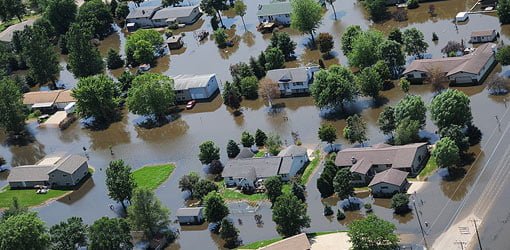
Aerial view of flooded homes in neighborhood (FEMA News Photo).
Along with warmer weather and greener scenery, spring can also bring severe storms, heavy rain, and flooding which can result in costly water damage to your home and the loss of valuable possessions. Here are seven tips to help protect your home from flooding and water damage.
Tip #1: Inspect and Repair Your Roof
A leaky roof can cause a lot more damage to your house than unsightly water stains on the ceiling. Roof leaks keep attic insulation wet, which can lead to rot and mold.
The unseen damage caused by roof leaks is often worse than what meets the eye, so it’s important to have it fixed as soon as possible. Having a reputable roofing contractor inspect your roof, check for undetected leaks, and make any needed repairs can prevent more costly damage down the road.
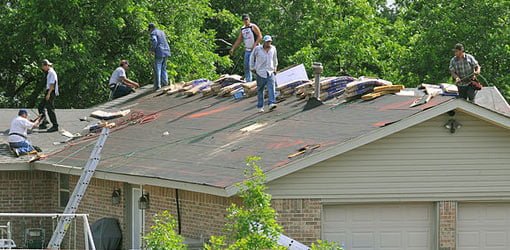
Replacing old roof on house (FEMA News Photo).
Tip #2: Document Your Possessions
Compiling a detailed home inventory of your personal possessions, backed up with photos and/or video, can be invaluable when processing an insurance claim in the aftermath of a flood or storm damage.
Keep the documentation in a waterproof container stored as high as possible away from rising water, and put a backup copy in a safe deposit box or other secure remote location.
It’s also a good idea to scan and maintain digital copies of all important records and keep them in a waterproof safe or a safety deposit box away from the house. That way, you’ll have more than enough evidence to support an insurance claim for damage caused by water or severe weather.
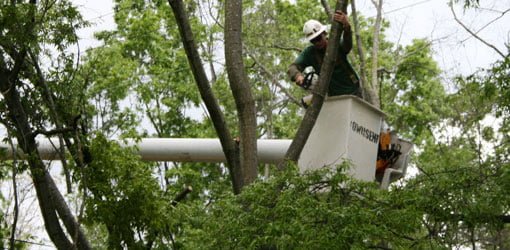
Trimming overhanging limbs on trees.
Tip #3: Trim Your Trees
To help prevent storm damage to your home, it’s important to trim tree branches that are growing near or hanging over your home to prevent them from breaking and crashing through the roof or damaging your siding during a storm.
Check to make sure all trees and large shrubs are alive and well, and remove any dead limbs or unhealthy plants. A dead plant may not seem like a threat, but it is more likely to be broken by strong winds during severe weather.
Tip #4: Clean Your Gutters and Downspouts
It’s also important to make sure to keep your gutters clean, repair any gutter leaks, and check regularly to see that they drain properly.
In addition, inspect your downspouts, remove any downspout clogs, and use splash blocks or downspout extension pipes to make sure the water is directed well away from your house foundation.
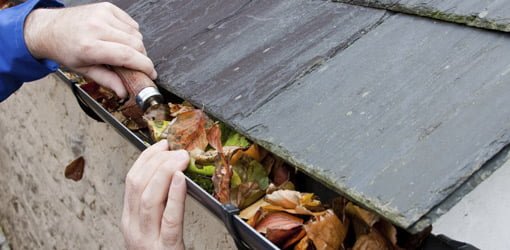
Cleaning leaves out of gutters.
Tip #5: Guard Your Foundation and Basement
To help keep your basement dry and prevent flooding around your home, make sure the ground slopes away from your home’s foundation by at least 6” over the first 10’. In addition, consider having a sump pump installed in your basement to remove any groundwater that seeps inside.
In case water does find its way inside your basement, leave a 1/2″ to 1” gap between the bottom of the drywall and the basement floor to prevent moisture from wicking up the wallboard and causing mold to grow within the walls. Hide the gap with strips of wood molding or rubberized floor trim.
For added peace of mind, some home security companies, such as Brinks Broadview, include flood detection among the services offered.
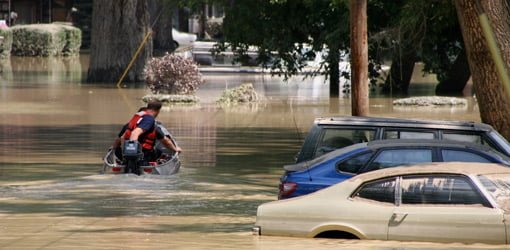
Boat on flooded street in neighborhood.
Tip #6: Install Sewer Backflow Valve
In flood prone areas, rising water may cause sewage to back up into your homes through the drainpipe. This not only can damage the interior of your home, but it is a health hazard as well.
To prevent this from happening, a backflow valve can be installed in the drain line. The valve has a flapper that closes automatically when needed, and may also include a manually operated valve for increased security.
Tip #7: Protect HVAC Equipment and Appliances
Flooding can also damage furnaces and air conditioning units, so make sure any HVAC equipment in flood prone areas is installed above the level that water might reach. If HVAC equipment can’t be elevated, consider placing it inside a concrete or masonry block wall.
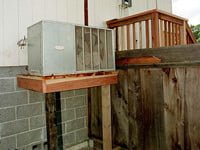
Elevated AC unit (FEMA News Photo).
Electrical systems components—including service panels, meters, switches, and outlets—should all be raised one foot or more above the base flood elevation (BFE).Washers and driers, especially those located in a basement or on the first floor of homes, should be placed on cinder blocks one foot above the BFE.
With the likelihood of increasing storms, hurricanes, and floods in the future; protecting your home from rising water and making sure your roof is in good condition are more important than ever.
https://www.todayshomeowner.com/protecting-your-home-from-water-damage-and-flooding/
